MLB: Top 5 Free Agent Pitchers Left for 2017

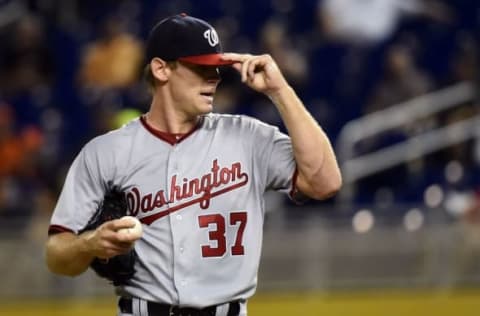
With Stephen Strasburg now off the market, here are the top MLB pitchers that will be available as free agents next offseason.
Starting pitching is difficult to find. As the game trends further toward drafting and developing your own talent, fewer and fewer pitchers are hitting free agency. Last year, prices skyrocketed for average arms, seeing players like Mike Leake get $80 million on the open market. Overall, there was close to a billion dollars spent on starting pitching with almost half belonging to two names – Zack Greinke (6/$206.5MM) and David Price (7/$217MM). In 2015, Max Scherzer became a $200 million man, and aging starters James Shields and Brandon McCarthy took home $75 and $55 million respectively.
Teams are trying harder than ever to keep their star players long-term, knowing that mistakes are made constantly in free agency as very few big-money deals work out. The Dodgers gave Clayton Kershaw $215 million a few months before his 26th birthday to keep him in Los Angeles until he’s 32; a deal that looks like a bargain compared to Price and Greinke. The Rays, longtime proponents of locking up young players early (see: Evan Longoria) gave Chris Archer a seven-year deal after starting only 27 MLB games. His $45MM deal (that includes two team options) will see him earn only $20 million total in his age 31 and 32 seasons, ones that should have been prime free agent earning years.
Related Story: Strasburg Inks Huge Deal With Nationals
After the Washington Nationals just inked free-agent-to-be Stephen Strasburg to a seven-year, $175 million dollar extension that kicks in next season, another top arm is off the market. Many expected Strasburg to be the newest member of the $200 million dollar club should teams get into a bidding war this offseason, so the Nationals got ahead of the pack so to speak. They still had to include an opt-out, the newest wrinkle in an ever changing contract structure norm. Strasburg will become a free agent when he is 31 or 32 should he choose to exercise the clause.
Strasburg was the gem of a weak free agent class, and it’s not even close. After him, it gets pretty ugly. Despite that, GMs around the league are sure to dish out way too much money and regret it on Opening Day 2017. Here are the top 5 pitchers set to hit the open market after 2016.
Next: Relievers
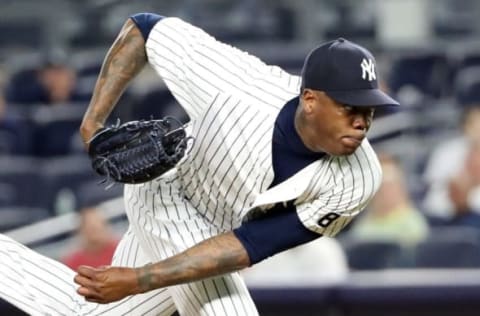
While starting pitchers get all the headlines, close to a quarter-billion dollars was handed out to relievers as well this offseason. Most of the names on the open market were setup men, making that number even more unbelievable. This year the relief group is better than the starters, as there are a number of top closers available.
Aroldis Chapmanmade his Yankees debut on Monday night, striking out two batters while allowing a run against the Kansas City Royals. While his recent suspension will knock a dollar or two off the deal he gets this offseason, it’s still undoubtedly going to shatter the previous record of $52 million. If the southpaw puts up another sub-2.00 ERA season, he may get closer to $100 million than you want to believe.
More from Call to the Pen
- Philadelphia Phillies, ready for a stretch run, bomb St. Louis Cardinals
- Philadelphia Phillies: The 4 players on the franchise’s Mount Rushmore
- Boston Red Sox fans should be upset over Mookie Betts’ comment
- Analyzing the Boston Red Sox trade for Dave Henderson and Spike Owen
- 2023 MLB postseason likely to have a strange look without Yankees, Red Sox, Cardinals
Next: Number 5
5. Mat Latos
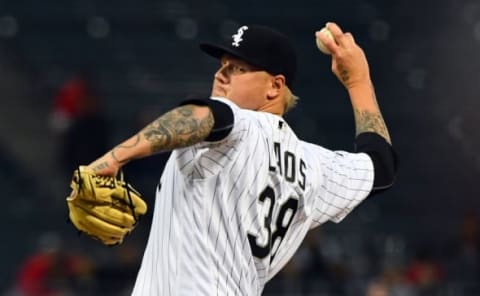
You might not believe it, but Mat Latos has much better career numbers than both Jeff Samardzija and Mike Leake. While last year was one to forget, being traded and then subsequently released, Latos actually put up some decent value on the season. His 4.95 ERA last year was by far the worst of his career, but actually comes in lower than the 4.96 that Samardzija put up in his final year in Chicago.
Latos had to settle for a one-year, $3 million dollar deal with the White Sox this offseason, because of both poor play and character issues. Latos has been rumored to be a problem in the clubhouse for years, though it never made it onto the field before last season.
He has gotten off to a great start for the Sox, going 5-0 with a 2.62 ERA through his first 5 starts. While his mid-4 FIP says that ERA won’t stay down there all season, he’s proving that he can at least be a reliable back-end starter in the AL.
The fact that Latos won’t even be 29 when this season ends will play big in his favor, as will any postseason experience he may get with the AL Central leading White Sox. This is a guy who put up four straight seasons of 3+ WAR from 2010-13 and will be in the middle of his prime.
The character issues, and questionable durability (Latos hasn’t thrown more than 116 innings in either of the past two seasons) will hold him back from getting a nine figure deal, but it wouldn’t be surprising to see him somewhere between J.A. Happ‘s $36 million and Leake’s $80 million. If he can get over that 200-inning mark again this year, and keep his ERA below 4.00, he may cash a big check this offseason.
Next: Number 4
4. R.A. Dickey
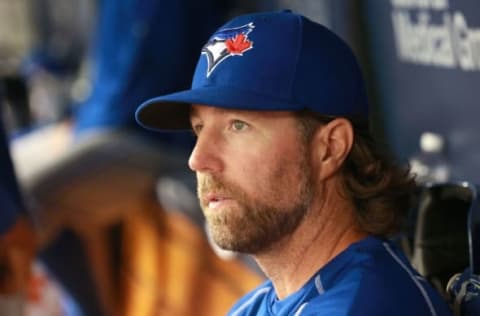
A 41-year-old starter is usually not at the top of very many free agent lists, but most of them can’t throw a knuckleball as well as R.A. Dickey. Whether you think the pitch is a gimmick or uncontrollable, you can’t complain about the results Dickey has gotten over his career. The former Cy Young winner has been the most reliable pitcher in the Blue Jays rotation since coming over from the Mets for Travis d’Arnaud and Noah Syndergaard – sorry Blue Jay fans – putting up 8.6 WAR from 2013-15.
Related Story: Is It Time To Move On From d'Arnaud?
While this season hasn’t started very well, Dickey is a notorious slow starter who tends to improve with the weather. The knuckleball is better in the heat, and as the temperature rises, usually so do Dickey’s results. This won’t happen forever obviously, but knucklers have been effective deep into their 40s before.
The Blue Jays have a tough call with Dickey at the end of the year, on whether or not to extend him a qualifying offer. It’s doubtful that teams would be giving a player of his age more than a two-year deal, and because of it Dickey might just accept the offer. If the Jays are willing to pay the nearly $17 million that the QO will be set at this offseason, then fine, but with a lot of money tied up in under-performing players already they might be a little gun shy.
While Dickey won’t get the big total due to his age, he could catch on with a team for upwards of $15 million a season. All this depends on the turnaround that is expected, but even if it’s only a partial rebound he’ll probably get a deal somewhere. Teams must beware though, that Dickey is basically two-roster spots, as he comes with personal catcher Josh Thole (or someone similarly experienced with a knuckler). Bad things happen when regular catchers try and work with the knuckleball, as Russell Martin found out firsthand last season.
Next: Number 3
3. Edinson Volquez

Edinson Volquez owes Pirates pitching coach Ray Searage about 100 steak dinners. After looking like he was on his way out of baseball, Volquez signed a one-year deal with Pittsburgh in 2014 and turned his career around. Volquez posted the lowest ERA of his career, going 13-7 for the Pirates in 192 innings.
Kansas City gave him $20 million for a couple of years after that, not buying totally into his turnaround, but willing to find out. Volquez became their most reliable pitcher last season, throwing over 200 innings for the first time in his career. His 2.6 WAR was the best since 2008, and he pitched well in the postseason en route to a World Series ring.
This season has been much of the same for Volquez, pitching to a solid if unspectacular 3.89 ERA with a promising 3.67 FIP to back it up. His velocity has stayed strong and his peripherals all look promising, despite the 3-3 record.
The Royals aren’t as good and might not even make it back to the playoffs, but if the soon-to-be 33-year-old puts together another 200-inning season and shows that he’s no longer the unreliable pitcher he was for much of his career, Volquez could get a nice paycheck this offseason.
He and the Royals have a mutual option for 2017, but since it’s worth just $10 million, Volquez is expected to turn it down. The Royals might then extend a qualifying offer, and if they do, look for him to sign for something between the $26 million that Marco Estrada got from the Blue Jays and the $32 million that John Lackey got. He’s a pitcher who could be significantly hurt by the QO system, as not many teams would want to lose a first rounder for him, even though he should be able to land a multi-year deal.
Next: Number 2
2. Andrew Cashner
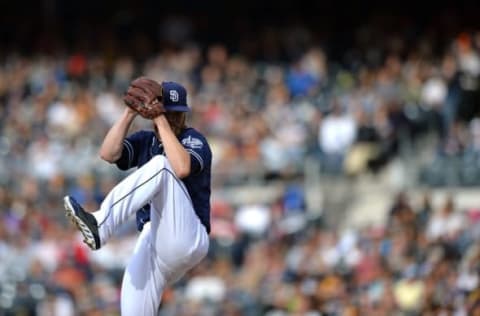
Sometimes it’s not just results that get paid on the open market. Sometimes potential gets just as much heat as anything else. Andrew Cashner has always been considered a potential ace, and while his results have been very good for the most part, he’s never been able to put together that dominating season.
A guy who can rev it up to 100 mph on occasion, Cashner’s stuff is off the charts. He’s had different levels of success over the past few years, including a solid 184.2-inning 2015. His 6-16 record might look bad, but it’s almost entirely due to the bad ball club that’s around him in San Diego, his FIP showing a half-run difference from the results he saw.
More from MLB News
- MLB Power Rankings: Atlanta Braves still on top with major shifting below them
- Caesars MLB Promo Code: Two Shots at Picking the World Series Winner!
- MLB Power Rankings: Atlanta Braves still on top amid a big shake-up in top 10
- DraftKings MLB Promo: Bet $5 on an Anytime Home Run, Win $150 Bonus GUARANTEED
- MLB Power Rankings: After MLB trade deadline, gap is closing on Atlanta Braves
This year hasn’t been great for the Padres right-hander, but again his FIP shows there is some room for regression. His velocity is sitting at a strong 93 mph, while he’s touched 98 with both his four-seam and two-seam fastballs. The stuff is still there, and there will be a lot of teams that hope they can unlock all that potential finally.
Cashner’s situation seems eerily similar to Jeff Samardzija’s spot last season. Samardzija had performed well, but not spectacularly throughout his career, but had always shown the dominant stuff that make teams salivate. He hit free agency a year earlier than Cashner will, and locked up a $90 million guarantee despite a terrible walk-season.
If Cashner can turn his season around even slightly and remain healthy for the year, he’s in for a big payday come December. He could easily push the $100 million mark, especially being one of the only big(ish) names on the market.
Next: Number 1
1. Shohei Otani
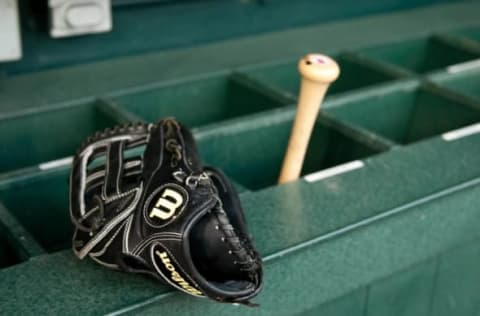
It might be a little unfair including Shohei Otani here, since he’s by no means guaranteed to be available this offseason, but rumors are starting to trickle in that he may finally ask his NPB team to post him and allow him to make the jump to MLB.
Source: #sluggingAce Shohei Otani might be interested in moving to #mlb IF teams see him as BOTH pitcher and batter.
— Jim Allen (@JballAllen) May 7, 2016
As you can see, Otani is a special case and one that would easily be the biggest on the pitching market. Otani is a two-way star in Japan, pitching once a week and playing DH for most of the other games. In seven starts this year he’s struck out 58 batters in 50.2 innings, running his fastball up to 100 mph at times. On offense, he’s slashing .308/.362/.654 with five home runs in just 58 PA.
Oh, and he’s still only 21.
Otani has always wanted to play in MLB, asking teams in Japan not to draft him out of high school and let him go to the United States right away. The Nippon Ham Fighters eventually convinced him to play for them though, promising him that he could play both ways for their squad. He’s said repeatedly however that his dream is still to play in MLB, and perhaps he’s getting closer to it.
If he were to ask his team to post him, and was granted it, all 30 teams in the majors would surely submit the $20 million dollar posting fee that is the new maximum for international players. After that, Otani would be allowed to negotiate with any team like a normal free agent.
If Otani were to make the jump to North America, he’d surely be kept as a pitcher as his potential there is far greater than as a hitter.
I'd take Shohei Ohtani over any pitcher on this list. #BA100 https://t.co/hBWMFNab7X
— Ben Badler (@BenBadler) February 13, 2016
Though it’s not a sure thing by any means that Otani will be posted this offseason, the mere fact that it’s a possibility puts him at the top of this list. The weak market would actually enhance his ability to get a huge contract (and it would be a huge contract), though that doesn’t do much for his NPB club. That $20 million is the maximum that they can receive, and this would seem to give little incentive to allow him to go. Most believe, however, that if the request was made the Fighters would allow him to go, despite his young age and strong play.
Next: Oldest Pitchers to Hit a Home Run
While the market seems incredibly thin, there are sure to be some fireworks in the pitching market this offseason. If Otani were to suddenly enter it, it would turn into a feeding frenzy immediately.